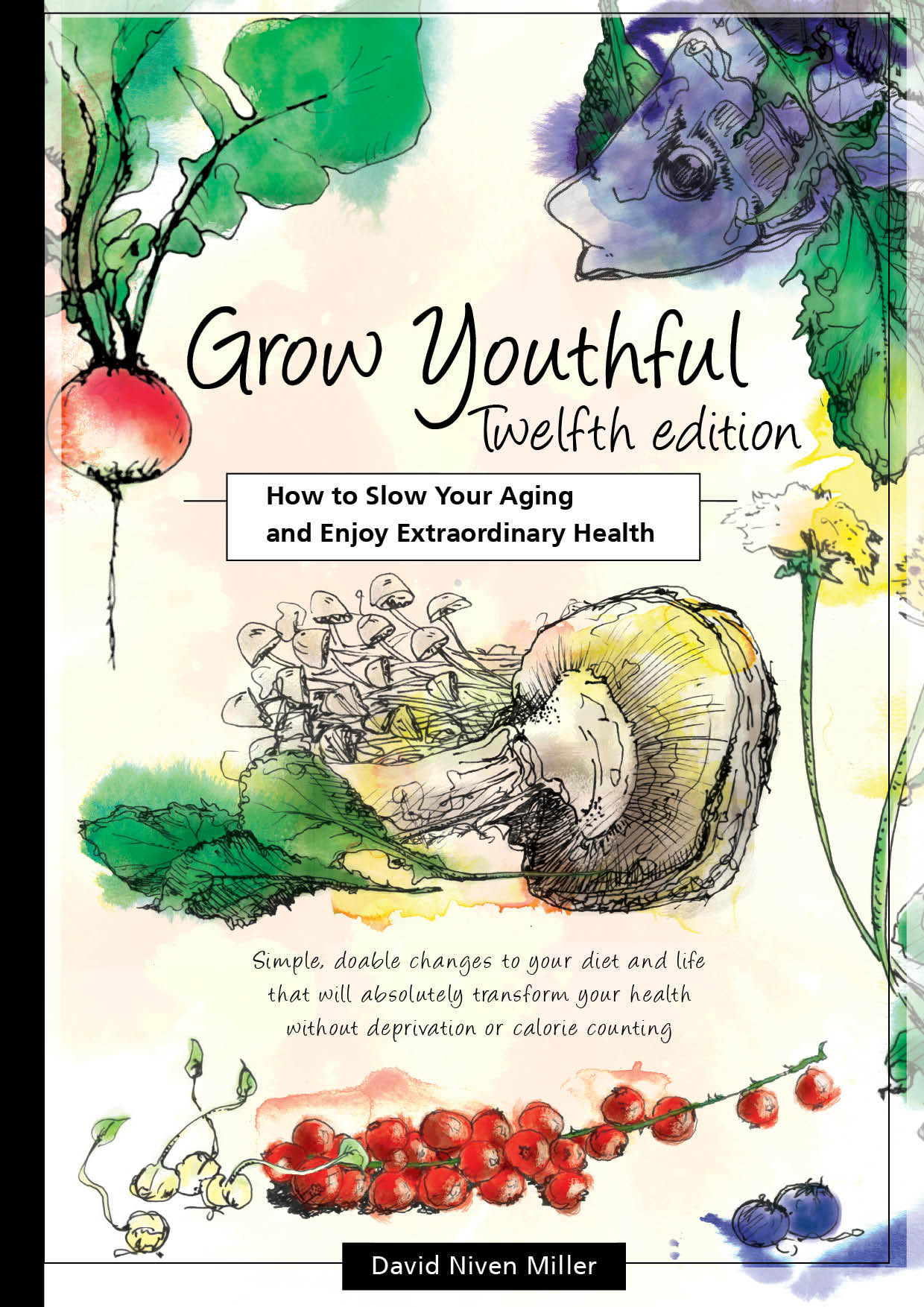
Keratosis
What is keratosis?
Keratosis pilaris
Actinic keratosis
Seborrheic keratosis
Other types of keratosis
Remedies for keratosis
References
What is keratosis?
Keratosis is an excessive growth of keratin, a skin protein, on the skin. There are a variety of causes which lead to several different types of keratosis.
The three most common types of keratosis are keratosis pilaris, actinic keratosis, and seborrheic keratosis. There are many others, most of which are rare or have an inherited (genetic) basis.
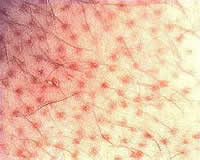
Keratosis pilaris
Keratosis pilaris (KP, follicular keratosis, chicken skin) is a common skin complaint that causes small, acne-like goose bumps. About 40% of all adult people have it, and 50-80% of all adolescents. It is often confused with acne, particularly because it is so common.
People call it "chicken skin" because of the appearance of rough, slightly red bumps on the skin. It most often appears on the back and on the outer sides of the upper arms, but can also occur on the thighs, tops of legs and buttocks. It does not occur on the palms and soles of the feet.
Keratosis pilaris is caused by excess keratin, a skin protein. The excess cream-coloured keratin blocks hair follicles with hard plugs. Occasionally a hair is trapped inside its follicle, causing an ingrown hair.
Keratosis pilaris is a classic sign of vitamin A deficiency. However, don't start dosing on vitamin A tablets - it is easy to overdose on this fat-soluble vitamin. Rather, try to get it from healthy foods that are rich in vitamin A, particularly liver. Other food sources include egg yolk, unpasteurised butter, cream, hard cheeses and full-fat milk. Getting your vitamin A from these healthy foods means that you get the co-factors necessary for the vitamin's absorption and use by your body. Plant sources such as carrots contain very little vitamin A.
Usually KP is insignificant, with only cosmetic consequence. The tiny hard bumps are seldom sore or itchy. KP can appear at any time, but tends to be worst during dry and cold months.
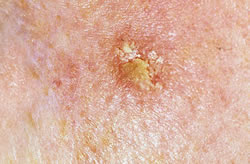
Actinic keratosis
Actinic (sun) keratosis is initially caused by getting burnt by the sun. Years later, other triggers may bring it on.
It is common, up to half of all people may eventually get an actinic keratosis during their lives.
It manifests as dry, thick, rough, crusty scales that can look a bit like scabs, but they do not heal and fall off. The lesions start out as flat scaly areas and can sometimes develop into a tough, wart-like growth. They vary in size from 2 to 10 mm, and may be dark or light, tan, pink, red or the same colour as the surrounding skin. They usually appear on the scalp of bald men, or on the face, lips, ears, neck, backs of hands, legs and arms - skin that has been over-exposed to the sun years previously.
Actinic keratoses can develop into the more benign types of skin cancers - BCC (basal cell carcinoma) or SCC (squamous cell carcinoma). About one in five of actinic keratoses progress to squamous cell carcinoma, so it is a good idea to treat them or have them frozen off.
Try to minimise sun exposure on the actinic keratosis lesions themselves, but not on healthy skin.
Causes of actinic keratosis:
- Excessive sun exposure. A badly burned skin, very red followed by skin peeling, is the initial cause. It may take a year or several years for actinic keratosis to appear.
- Zinc insufficiency.
- Arsenic toxicity.
- Weak immune system, immune stress, or use of immunosuppressive drugs (such as with organ transplant patients).
- Age. Older people are more affected.
- Excessive saturated fat in the diet. "A high fat intake increases the likelihood of skin cancer (and actinic keratosis) after exposure to ultraviolet radiation." (8) Another study reduced the fat in the subject's diet from 40% of total calorie intake to 21%. Over the following two years the incidence of actinic keratosis was 70% lower than that of the control group. (3, 4, 5, 6, 7, 8)
- Viral infection. It is likely that human papillomavirus is involved in the development of actinic keratoses. (1)
- Skin colour. It is more common in fair/white-skinned people.
Seborrheic keratosis
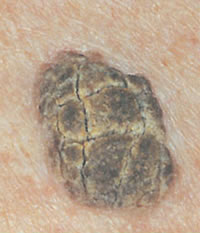
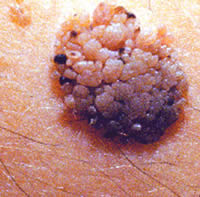
Seborrheic keratosis (Seborrheic verruca, senile wart) look somewhat like warts, but they are not the same because warts are caused by a virus. Seborrheic keratosis can also be confused with skin tags, and can also resemble melanoma, but are unrelated as well. They are round or oval, and feel flat or slightly elevated, and look like they are glued onto the skin. Size can range from very small to 2.5 cm (1 inch) diameter. Colour can range from beige or light tan through to black. They can be found all over the body, including on skin that has not been exposed to the sun. They are common on older people.
Seborrheic keratosis is benign and no treatment is usually necessary. Occasionally they can become infected if you pick at them. To remove them for cosmetic reasons, the easiest treatment is to freeze them off with liquid nitrogen. Laser or electric burning off is also possible.
This type of keratosis tends to be more prevalent with increasing age, and those with weaker immune systems. There is some evidence that it is associated with stress (prolonged stress has a negative effect on the immune system).
Causes of seborrheic keratosis:
- Age. Older people are more affected.
- Zinc insufficiency.
- Weak immune system, immune stress, or use of immunosuppressive drugs (such as with organ transplant patients).
- Fat metabolism faulty. Excessive polyunsaturated omega-6 oils compared to saturated fats. In other words, consuming vegetable oils made from seeds, grains and legumes rather than saturated fats derived from animal products. (4, 5, 6, 7)
- Viral infection. It is likely that human papillomavirus is involved in the development of actinic keratoses. (1)
- Arsenic toxicity.
Other types of keratosis
Quite a common form of keratosis in black-skinned people are depressions 1-5mm deep, filled with a stick-like plug.
Hydrocarbon keratosis (pitch keratosis, tar keratosis, tar wart) is a precancerous keratotic skin lesion that occurs in people who have been exposed to polycyclic aromatic hydrocarbons.
There are several other forms of keratosis, most of which are very rare. Keratosis can occur on the palms of the hands and soles of the feet. This is usually an inherited genetic condition which first occurs in infancy or childhood. Another form of keratosis, which also begins in infancy, can start on the eyebrows, spread to the cheeks and forehead, and further over the years. Yet another form occurs as yellow-white dots on the back of throat and mouth. They cannot be wiped off, and may hurt a little. In most cases, this throat form eventually goes away on its own.
Remedies for keratosis
- Zinc is the most common mineral deficiency causing different types of keratosis. Zinc supports the immune system, and often has a beneficial effect on keratoses. As I explain on the Grow Youthful zinc web page, it is easy to test for a zinc deficiency, so the first thing to try is usually zinc.
- Low fat diet, particuarly saturated fats. See causes of actinic keratoses above. (3, 4, 5, 6, 7, 8)
- Liquid nitrogen. The most common medical treatment for keratoses is to freeze them with liquid nitrogen. Applied with a cotton bud/tip to the lesion. It scabs and falls off in a week or two. However, they often reappear in the same spot months or years later. Keratoses can also be burned off with laser / electricity.
- Sufficient micronutrients in the body. Keratosis is often a disease of malnutrition caused by sugar, toxic food and weak digestion. Micronutrients may be deficient, particularly vitamin A, vitamin D, magnesium and zinc. Keratosis pilaris is a classic sign of vitamin A deficiency. Good digestion and a living food, nutrient-rich diet help considerably. One reason that keratoses are common in the elderly is that they often suffer from weak digestion causing deficiency of a range of minerals and other nutrients.
A study on actinic keratosis found protection among those consuming oily fish at least every five days, and who drank half a glass of wine per day. (2) - Milkweed (euphorbia peplus).
- Frankincense (olibanum). Frankincense essential oil made from Boswellia carterii, B. sacra, B. bhaw-dajiana, B. serrata, B. papyrifera, B. frereana, B. occulta. Some of the healing molecules in frankincense essential oil can pass through the blood brain barrier, and several compounds have been identified that have anti-cancer properties. Some of these properties are particularly effective for the treatment of actinic keratosis. (9)
- Castor oil.
- Sunlight. May improve or worsen the condition, depending on the particular patient. Avoid excessive sun exposure on the keratosis itself, especially if suffering from actinic keratosis. However, vitamin D is essential for good health, so try to get some gentle sunlight on other parts of your body and monitor how you feel.
- View remedies & comments contributed by visitors to Grow Youthful's Ailments & Remedies pages.
References
1. Soenke Jan Weissenborn, Ingo Nindl, Karin Purdie, Catherine Harwood, Charlotte Proby, Judy Breuer, Slawomir Majewski, Herbert
Pfister, Ulrike Wieland.
Human Papillomavirus-DNA Loads in Actinic Keratoses Exceed those in Non-Melanoma Skin Cancers.
Journal of Investigative Dermatology (2005) 125, 93-97.
2. Maria Celia B Hughes, Gail M Williams, Anny Fourtanier, Adele C Green.
Food intake, dietary patterns, and actinic keratoses of the skin: a longitudinal study.
Am J Clin Nutr April 2009 vol. 89 no. 4 1246-1255.
3. H S Black, J A Herd, L H Goldberg, J E Wolf, J I Thornby, T Rosen, S Bruce, J A Tschen, J P Foreyt, L W Scott.
A low-fat diet reduces the incidence of actinic keratosis in patients with a history of nonmelanoma skin cancer.
5 May 1994. N Engl J Med. 330(18):1272-5. PMID: 8145782.
4. Suzanne Jaax, Lynne W. Scott, John E. Wolf Jr., John I. Thornby, Homer S. Black.
General guidelines for a low-fat diet effective in the management and prevention of nonmelanoma skin cancer.
Nutrition and Cancer, Volume 27, 1997 - Issue 2, Pages 150-156. Published online 04 Aug 2009.
5. Liang Ruan, Shuang-Ping Cheng, Qi-Xing Zhu.
Dietary Fat Intake and the Risk of Skin Cancer: A Systematic Review and Meta-Analysis of Observational Studies. Nutrition and Cancer (2020). 72:3, pages 398-408.
6. Homer S Black.
Nutritional lipid and antioxidant supplements: risks versus benefits.
(2012). Expert Review of Dermatology 7:5, pages 483-492.
7. Homer S Black.
Can diet prevent nonmelanoma skin cancer progression?
(2005). Expert Review of Anticancer Therapy, 5:5, pages 801-808.
8. Homer S. Black, J. Alan Herd, Leonard H. Goldberg, John E. Wolf, Jr., John I. Thornby, Theodore Rosen, Suzanne Bruce, Jaime A. Tschen, John P. Foreyt, Lynne W. Scott, Suzanne Jaax, Kelly Andrews.
Effect of a Low-Fat Diet on the Incidence of Actinic Keratosis.
5 May 1994. N Engl J Med 1994; 330:1272-1275. DOI: 10.1056/NEJM199405053301804.
9. Hans-Ulrich Jabs.
Treatment of actinic keratoses with a new olibanum extract.
Kosmetische Medizin, 2005 (4), 184-185. Revision 27/5/2021.
